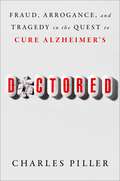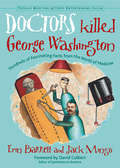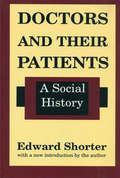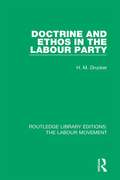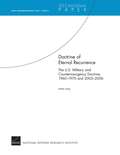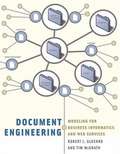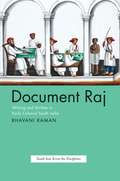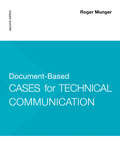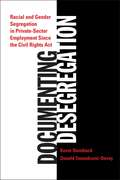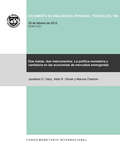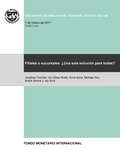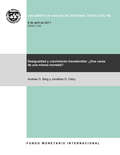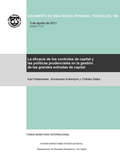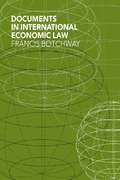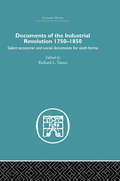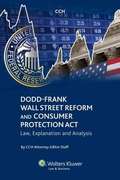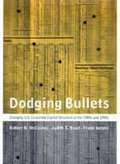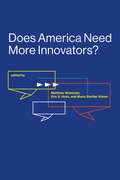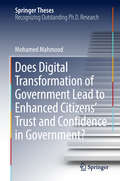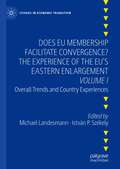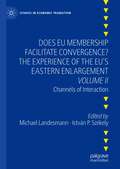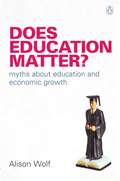- Table View
- List View
Doctored: Fraud, Arrogance, and Tragedy in the Quest to Cure Alzheimer's
by Charles Piller&“Demonstrates how some of the most accomplished and elite scientific gatekeepers may have lied, cheated, squandered trust and endangered lives.&” —The Wall Street Journal For readers of Empire of Pain and Dopesick, an arresting deep dive into how Alzheimer&’s disease treatment has been set back by corrupt researchers, negligent regulators, and the profit motives of Big Pharma. Nearly seven million Americans live with Alzheimer&’s disease, a tragedy that is already projected to grow into a $1 trillion crisis by 2050. While families suffer and promises of pharmaceutical breakthroughs keep coming up short, investigative journalist Charles Piller&’s Doctored shows that we&’ve quite likely been walking the wrong path to finding a cure all along—led astray by a cabal of self-interested researchers, government accomplices, and corporate greed. Piller begins with a whistleblower—Vanderbilt professor Matthew Schrag—whose work exposed a massive scandal. Schrag found that a University of Minnesota lab led by a precocious young scientist and a Nobel Prize–rumored director delivered apparently falsified data at the heart of the leading hypothesis about the disease. Piller&’s revelations of Schrag&’s findings stunned the field and the public. From there, based on years of investigative reporting, this &“seminal account of deceit that will long be remembered&” (Katherine Eban, author of Bottle of Lies and Vanity Fair special correspondent) exposes a vast network of deceit and its players, all the way up to the FDA. Piller uncovers evidence that hundreds of important Alzheimer&’s research papers are based on false data. In the process, he reveals how even against a flood of money and influence, a determined cadre of scientific renegades have fought back to challenge the field&’s institutional powers in service to science and the tens of thousands of patients who have been drawn into trials to test dubious drugs. It is a shocking tale with huge ramifications not only for Alzheimer&’s disease, but for scientific research, funding, and oversight at large.
Doctors Killed George Washington: Hundreds of Fascinating Facts from the World of Medicine
by Jack Mingo Erin BarrettThe marvel of medicine spans the tribal shamanism of prehistory to simple herbalism to today's technological feats. To study its history is to encounter case after case of the wonderful accident of it, wherein some combination of genius, observation, perseverance, coincidence, and just plain luck came together to move medical science forward. DOCTORS KILLED GEORGE WASHINGTON is a collection of approximately 500 fascinating facts about doctors.
Doctors and Their Patients: A Social History
by Edward ShorterWith every passing year, the mutual mistrust between doctor and patient widens, as doctors retreat into resentment and patients become increasingly disillusioned with the quality of care. Rich in anecdote as well as science 'Doctors and Their Patients' describes how both have arrived at this sad shape.
Doctrine and Ethos in the Labour Party (Routledge Library Editions: The Labour Movement #12)
by H. M. DruckerFirst published in 1979. In this important study of Labour Party ideology, the author sought to provoke his readers to a fundamental re-evaluation of the party and of the relationships between the party, Labour ideology and socialist doctrine. What he had to say would have disturbed left and right wings alike within the party, while remaining accessible to students and general readers at all levels who have an interest in the considered analysis of British politics and the concept of ideology.
Doctrine of Eternal Recurrence--The U.S. Military and Counterinsurgency Doctrine, 1960-1970 and 2003-2006
by Austin LongBy comparing modern counterinsurgency doctrine and operations to those of 1960s, this paper tests and ultimately disproves the assumption that doctrine as written and operations as conducted are tightly linked. Ingrained organizational concepts and beliefs have a much greater influence on operations than written doctrine, and altering these beliefs will require the U.S. military to reorient itself mentally as well as physically.
Document Engineering: Analyzing and Designing Documents for Business Informatics and Web Services
by Robert J. Glushko Tim McgrathMuch of the business transacted on the Web today takes place through information exchanges made possible by using documents as interfaces. For example, what seems to be a simple purchase from an online bookstore actually involves at least three different business collaborations--between the customer and the online catalog to select a book; between the bookstore and a credit card authorization service to verify and charge the customer's account; and between the bookstore and the delivery service with instructions for picking up and delivering the book to the customer. Document engineering is needed to analyze, design, and implement these Internet information exchanges. This book is an introduction to the emerging field of document engineering. The authors, both leaders in the development of document engineering and other e-commerce initiatives, analyze document exchanges from a variety of perspectives. Taking a qualitative view, they look at patterns of document exchanges as components of business models; looking at documents in more detail, they describe techniques for analyzing individual transaction patterns and the role they play in the overall business process. They describe techniques for analyzing, designing, and encoding document models, including XML, and discuss the techniques and architectures that make XML a unifying technology for the next generation of e-business applications. Finally, they go beyond document models to consider management and strategic issues--the business model, or the vision, that the information exchanged in these documents serves.
Document Raj: Writing and Scribes in Early Colonial South India
by Bhavani RamanHistorians of British colonial rule in India have noted both the place of military might and the imposition of new cultural categories in the making of Empire, but Bhavani Raman, in "Document Raj," uncovers a lesser-known story of power: the power of bureaucracy. Drawing on extensive archival research in the files of the East India CompanyOCOs administrative offices in Madras, she tells the story of a bureaucracy gone awry in a fever of documentation practices that grew ever more abstractOCoand the power, both economic and cultural, this created. aIn order to assert its legitimacy and value within the British Empire, the East India Company was diligent about record keeping. Raman shows, however, that the sheer volume of their document production allowed colonial managers to subtly but substantively manipulate records for their own ends, increasingly drawing the real and the recorded further apart. While this administrative sleight of hand increased the companyOCOs reach and power within the Empire, it also bolstered profoundly new orientations to language, writing, memory, and pedagogy for the officers and Indian subordinates involved. Immersed in a subterranean world of delinquent scribes, translators, village accountants, and entrepreneurial fixers, "Document Raj" maps the shifting boundaries of the legible and illegible, the legal and illegitimate, that would usher India into the modern world.
Document-Based Cases for Technical Communication
by Roger MungerWith seven context-rich scenarios and more than 50 sample documents to analyze, revise, and design, this booklet offers students realistic opportunities to practice writing in the workplace. The new edition features a fresh new design and new cases and writing tasks that incorporate online genres and social media tools. A companion Web site provides digital versions of all the documents in the book for students to download and work with as well as new scoring guides for instructors.
Documenting Desegregation: Racial and Gender Segregation in Private Sector Employment Since The Civil Rights Act
by Kevin Stainback Donald Tomaskovic-DeveyEnacted nearly fifty years ago, the Civil Rights Act codified a new vision for American society by formally ending segregation and banning race and gender discrimination in the workplace. But how much change did the legislation actually produce? As employers responded to the law, did new and more subtle forms of inequality emerge in the workplace? In an insightful analysis that combines history with a rigorous empirical analysis of newly available data, Documenting Desegregation offers the most comprehensive account to date of what has happened to equal opportunity in America--and what needs to be done in order to achieve a truly integrated workforce. Weaving strands of history, cognitive psychology, and demography, Documenting Desgregation provides a compelling exploration of the ways legislation can affect employer behavior and produce change. Authors Kevin Stainback and Donald Tomaskovic-Devey use a remarkable historical record--data from more than six million workplaces collected by the U. S. Equal Employment Opportunity Commission (EEOC) since 1966--to present a sobering portrait of race and gender in the American workplace. Progress has been decidedly uneven: black men, black women, and white women have prospered in firms that rely on educational credentials when hiring, though white women have advanced more quickly. And white men have hardly fallen behind--they now hold more managerial positions than they did in 1964. The authors argue that the Civil Rights Act's equal opportunity clauses have been most effective when accompanied by social movements demanding changes. EEOC data show that African American men made rapid gains in the 1960s at the height of the Civil Rights movement. Similarly, white women gained access to more professional and managerial jobs in the 1970s as regulators and policymakers began to enact and enforce gender discrimination laws. By the 1980s, however, racial desegregation had stalled, reflecting the dimmed status of the Civil Rights agenda. Racial and gender employment segregation remain high today, and, alarmingly, many firms, particularly in high-wage industries, seem to be moving in the wrong direction and have shown signs of resegregating since the 1980s. To counter this worrying trend, the authors propose new methods to increase diversity by changing industry norms, holding human resources managers to account, and exerting renewed government pressure on large corporations to make equal employment opportunity a national priority. At a time of high unemployment and rising inequality, Documenting Desegregation provides an incisive re-examination of America's tortured pursuit of equal employment opportunity. This important new book will be an indispensable guide for those seeking to understand where America stands in fulfilling its promise of a workplace free from discrimination.
Documento de Análisis del Personal Técnico del FMI
by Fondo Monetario InternacionalStaff Discussion Notes showcase the latest policy-related analysis and research being developed by individual IMF staff and are published to elicit comment and to further debate. These papers are generally brief and written in nontechnical language, and so are aimed at a broad audience interested in economic policy issues. This Web-only series replaced Staff Position Notes in January 2011.
Documento de Análisis del Personal Técnico del FMI
by Fondo Monetario InternacionalA report from the International Monetary Fund.
Documento de Análisis del Personal Técnico del FMI
by Fondo Monetario InternacionalA report from the International Monetary Fund.
Documento de Análisis del Personal Técnico del FMI
by Fondo Monetario InternacionalA report from the International Monetary Fund.
Documents in International Economic Law
by Francis BotchwayPresents the full texts of over 100 international treaties and agreements to provide an essential understanding of the global economy and trade.Appearing chronologically, the treaties encompass a period of world history that includes the Treaty of Westphalia (1648) and the Marrakesh Agreement Establishing the World Trade Organization (1994), to provide both an up-to-date record and an indispensable background in the study of international economic law.The following information is given for each treaty and agreement:* Date of first signing, ratification and entry into force* Dates and texts of subsequent treaty revisions* Tables giving membership lists of treaties, along with dates of signing.
Documents of the Industrial Revolution 1750-1850: Select Economic and Social Documents for Sixth forms
by Richard L. TamesThis fascinating collection presents industrialization as a total historical process involving the destruction of one world simultaneously with the creation of another. Divided into two sections, it deals with elements of life such as the organization of labour, the health of the nation, rural and industrial societies, and poverty. The first section (The Expanding Economy) outlines the process by which economic growth took place and the second (The Social Impact) shows the impact this growth had on the society which both promoted and resisted it.
Documentum, Inc.
by Rajiv Lal Sean LanaganDescribes Jeff Miller's attempt to implement Geoffrey Moore's crossing the chasm ideas at enterprise software vendor, Documentum.
Dodd-Frank Wall Street Reform and Consumer Protection Act: Law, Explanation and Analysis
by Cch IncorporatedDodd-Frank Wall Street Reform and Consumer Protection Act: Law, Explanation and Analysis provides comprehensive analysis of this sweeping new banking and securities legislation. Passed by the House of Representatives on June 30 and by the Senate on July 15, the Dodd-Frank Wall Street Reform and Consumer Protection Act was signed into law by the President on July 21,2010.
Dodging Bullets: Changing U. S. Corporate Capital Structure in the 1980s and 1990s
by Robert N. Mccauley Judith S. Ruud Frank IaconoThe late 1980s saw a huge wave of corporate leveraging. The U. S. financial landscape was dominated by a series of high-stakes leveraged buyouts as firms replaced their equity with new fixed debt obligations. Cash-financed acquisitions and defensive share repurchases also decapitalized corporations. This trend culminated in the sensational debt-financed bidding for RJR-Nabisco, the largest leveraged buyout of all time, before dramatically reversing itself in the early 1990s with a rapid return to equity. This entertaining summary of the broad reshaping of U. S. corporate finance in the last decade and a half looks at three major issues: why corporations leveraged up in the first place, why and how the leverage wave came to an end, and what policy lessons are to be drawn. Using the Minsky-Kindleberger model as a framework, the authors interpret the rise and fall of leveraging as a financial market mania. In the course of chronicling the return to equity in the 1990s, they address a number of important corporate finance questions: How important was the return to equity in relieving corporations' debt burdens? How did the return to equity affect the ability of young high-tech firms to finance themselves without selling out to foreign firms?
Doen wat werkt !
by M. van der Burgt E. van Mechelen-GeversGezondheidsvoorlichting en –bevordering (GVO) en preventie vormen samen een specifieke verpleegkundige competentie. In deze praktische handleiding komen alle aspecten van (groeps)voorlichting aan bod. Het boek gaat uit van de huidige praktijk van gezondheidsvoorlichting door verpleegkundigen. Door de vele voorbeelden in dit boek kan elke verpleegkundige situaties en problemen uit de eigen beroepspraktijk herkennen. Er is gekozen voor een praktische benadering. Zo behandelt het boek de actiepunten voor het verzorgen van een voorlichtingsbijeenkomst en het ontwikkelen van een lokaal gezondheidsproject. Door de methodische benadering en het presenteren van evidence en good practice levert het boek een bijdrage aan de verdere professionalisering van de verpleegkundige op het gebied van gezondheidsvoorlichting. Voorbeelden en interviews maken de theorie van gezondheidsvoorlichting inzichtelijk en praktisch bruikbaar. Programmavoorbeelden, evaluatieformulieren en checklists zijn opgenomen als hulpmiddelen voor de verpleegkundige praktijk. Met dit boek kan de verpleegkundige direct aan de slag.
Does Aid Work in India?: A Country Study of the Impact of Official Development Assistance (Routledge Library Editions: Development)
by Michael Lipton John ToyeMuch about India's economy and aid flows has changed in the last two decades. India's growth rate has quickened since economic liberalisation, the poverty head count has fallen and the volume and composition of its aid have changed as new issues of climate change and the environment have emerged..Yet Does Aid Work in India?, first published in 1990, remains of great interest as a study of aid effectiveness in India's pre-liberalisation era. It identifies those sectors where aid-funded interventions succeeded, and where they failed. It explains how India avoided problems of aid dependence, and managed the political tensions that are associated with aid policy dialogue. More generally, it contains a useful commentary on and criticism of donors' aid evaluation procedures at that time and it highlights donor efforts in the difficult area of institution building. Despite the passage of time, many of the insights from India's earlier experience remain highly relevant to key issues of development assistance today.
Does America Need More Innovators? (Lemelson Center Studies in Invention and Innovation series)
by Matthew Wisnioski Eric S. Hintz Marie Stettler KleineA critical exploration of today's global imperative to innovate, by champions, critics, and reformers of innovation.Corporate executives, politicians, and school board leaders agree—Americans must innovate. Innovation experts fuel this demand with books and services that instruct aspiring innovators in best practices, personal habits, and workplace cultures for fostering innovation. But critics have begun to question the unceasing promotion of innovation, pointing out its gadget-centric shallowness, the lack of diversity among innovators, and the unequal distribution of innovation's burdens and rewards. Meanwhile, reformers work to make the training of innovators more inclusive and the outcomes of innovation more responsible. This book offers an overdue critical exploration of today's global imperative to innovate by bringing together innovation's champions, critics, and reformers in conversation. The book presents an overview of innovator training, exploring the history, motivations, and philosophies of programs in private industry, universities, and government; offers a primer on critical innovation studies, with essays that historicize, contextualize, and problematize the drive to create innovators; and considers initiatives that seek to reform and reshape what it means to be an innovator.ContributorsErrol Arkilic, Catherine Ashcraft, Leticia Britos Cavagnaro, W. Bernard Carlson, Lisa D. Cook, Humera Fasihuddin, Maryann Feldman, Erik Fisher, Benoît Godin, Jenn Gustetic, David Guston, Eric S. Hintz, Marie Stettler Kleine, Dutch MacDonald, Mickey McManus, Sebastian Pfotenhauer, Natalie Rusk, Andrew L. Russell, Lucinda M. Sanders, Brenda Trinidad, Lee Vinsel, Matthew Wisnioski
Does Digital Transformation of Government Lead to Enhanced Citizens’ Trust and Confidence in Government? (Springer Theses)
by Mohamed MahmoodThis research contributes to the growing body of knowledge as well as offers significant theoretical contributions and policy implications. As far as the researcher’s knowledge, this is the first research of its type that investigates the relationship between digital enabled transformation of government and citizens’ trust & confidence in government. The proposed conceptual model also makes a novel contribution at a conceptual level, which can be used as a frame of reference by researchers as well as practitioners when planning ICT-enabled transformation projects in government. The context of the research is the Kingdom of Bahrain, the top-ranked country in ICT adoption in the Gulf Cooperation Council (GCC) region.
Does EU Membership Facilitate Convergence? The Experience of the EU's Eastern Enlargement - Volume I: Overall Trends and Country Experiences (Studies in Economic Transition)
by István P. Székely Michael LandesmannThis edited volume analyses how EU membership influenced the convergence process of member countries in the Baltics, Central-Eastern and South-Eastern Europe. It also explores countries that are candidates for future EU membership. The speed of convergence of significant groups of low- and medium-income countries has never been as fast globally as it is today. Contributions by lead researchers of the area explore whether these countries are converging faster than their fundamentals and global trends would suggest because of EU membership, with its much tighter institutional and political anchorage
Does EU Membership Facilitate Convergence? The Experience of the EU's Eastern Enlargement - Volume II: Channels of Interaction (Studies in Economic Transition)
by István P. Székely Michael LandesmannThis edited volume analyses the channels through which EU membership contributed to the convergence process of member countries in the Baltics, Central-Eastern and South-Eastern Europe. These channels include trade, investment, finance, labour, and laws and institutions. Global integration has certainly played an important role. A large part of FDI flows and financial integration in the world have been persistent features of globalization. Have these countries experienced more intensive integration through these channels because of EU membership, with its much tighter institutional and political anchorage, than their fundamentals and global trends would suggest? Contributions by lead researchers of the area address different aspects of this question. .
Does Education Matter?: Myths About Education and Economic Growth
by Alison Wolf"Education, education, education" has become an obsession for politicians and the public alike. It is seen as an economic panacea: an engine for growth and prosperity. But is there a link between increased spending on higher eductaion and economicgrowth? Professor Alison Wolf takes a critical look at successive governments' education policy and challenges many of the tenets of received wisdom: there are no economic reasons for spending more on higher education in order to stimulate growth. The conclusion of this devastating book is that a large proportion of the billions poured into vocational training and university provision might be better spent on teaching the basics at primary school.
